Don't wanna be here? Send us removal request.
Text
Best Meditation Tips for Beginners
Are you interested to do meditation but do not know where to start? Don't worry because there are definitely a few easy steps as to how you can go about doing meditation. As a matter of fact, these easy to do tips are so simple that you do not necessarily need assistance of an expert if you follow it carefully.
For a long time now, meditation has been used by many for a variety of reasons. In the old times, meditation was a way of communicating with the Buddha or achieve a higher level of consciousness because the practice of meditation first started with the ancient Buddhists. Meditation was not just a way of relieving oneself from stress but more of actually being able to keep the balance in one's self and exercising the mind to concentrate and focus. For beginners who do not know what to do when meditating there are a few tips they can make use of.

Learn about the Breathing Techniques. In meditation, one of the first few things that is needs to be learned is proper breathing techniques. To do this, you must first sit comfortably (either on a chair or on the floor) with legs crossed or the Indian sit. Place your palms on each leg with palms facing up. Close your eyes and start to listen to the things happening around you. Start paying close attention to your breathing making sure to slowly inhale and breathe out through your lips. Do this in a slow manner until you are able to concentrate on without being distracted of the noise around you or be bothered by thoughts running through your head.
Pick a place to meditate. You do not necessarily have to go far and wide and go to mountain tops just to meditate. Even a corner of your bedroom is already more than enough to be able to meditate. The important thing in making meditation successful is to be able to find a place where the noise is minimal and is free of distractions.
Make use of music and other things if needed. There are actually music that are really meant for meditation. It usually entails the use of ancient musical instruments or the sounds of nature such as the gushing water or the sound of the wind and the trees. These are actually a few things that can help you concentrate. You can also make use of scented candles if you like to make meditation more inviting.
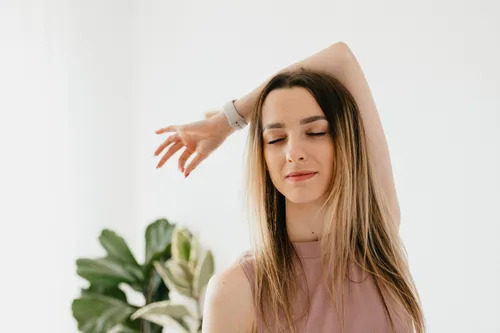
Practice makes perfect. Remember the old cliché that practice makes perfect? It is very much applicable to meditation for beginners to. To concentrate and not have to think of anything is hard. It could be frustrating after a few tries but doing it regularly allows you to focus clearly and be able to perfect and master the art of meditation.
These meditation tips for beginners are the most basic. If you want to know more as to how to meditate you have the option of searching over the net, making use of books or enroll yourself in a meditation class if you like.
2 notes
·
View notes
Photo

How To Intensify Your Yoga Routine.
498 notes
·
View notes
Photo

Yoga Tips To Get You Through the Holidays
317 notes
·
View notes
Photo

@yongxianyoga
COBRA VS UPWARD FACING DOG
1. In UFD, the legs, pelvis & torso are lifted. The tops of your feet press firmly down, & palms are grounded to help support your upper body. In Cobra, the legs & pelvis are grounded, & only the torso is lifted. Note there’s a difference between High Cobra & Low Cobra – I’ll explain below. 2. Both poses are usually done as part of a Vinyasa. If you can manage a Chaturanga, the pose you’d normally flow into after that would be UFD. But if you’re lacking in upper body strength & you’re coming down into Knees-Chest-Chin from plank, you’d move into Cobra. •
COBRA Legs & pelvis:
Legs & pelvic bones are grounded. I like to keep my feet mat width apart (wider than usual) to arch my middle back more, instead of jamming into the lower back. Arms: In the photo, my elbows are a little bent. In (High) Cobra, there is no real need to straighten the elbows all the way – doing that may cause compression in the lower back. Keep your elbows bent as much as you need to arch your back evenly & gradually. Palms are shoulder width, slightly in front of shoulders. Modification: Low Cobra is an easier alternative. To do this, bring the belly onto the floor, so only chest is lifted. Hands will be under your shoulders, next to your chest, elbows hug in. •
UPWARD FACING DOG Spine:
The tendency here is pushing up through yr arms, creating an L shape in your spine, causing compression. To correct this, pull your chest forward & through by pulling yr shoulders back. Arms: Elbows are straight, but keep them micro bent, engaging your triceps. Palms are a bit closer to you as opposed to Cobra. Modification: In a Vinyasa, UFD usually comes aft Chaturanga, but pushing up from that to UFD requires a lot of core & arm strength, & if you’re lacking in upper body strength, this transition may be tough. If you’re still working on this, you can drop your knees to come into Cobra, or drop the knees first then push up into UFD. Whatever feels good! • Experiment with both and see which feels more comfortable for you. Just remember there should be no pain, and try your best to arch the entire spine gradually – not just the lower back. Be safe x #yongxianyogatips
87 notes
·
View notes
Photo










Yoga Poses that Help Build Muscles for Inversions By: Sunny Yogi
For inversions, arm and core strength are really important. Here are some of my favorite poses that I like to incorporate into my practice that help strengthen my body up for inversions.
I am not a certified yoga teacher and these poses are just based off of my experience.
Downward Facing Dog: This pose is great for building up muscle in the arms and shoulders. You can also do 3 legged downward dog to add a stretch in the legs.
Dolphin Pose: This pose is great for shoulders and triceps. This is also a great prep pose for forearm stands.
Chaturanga: I incorporate a lot of these into my practice. Chaturanga’s are great for arm and core strength. You could do a three legged chaturanga if you want to give yourself a little challenge :)
Plank: A great pose for building strength in the core. You can go on your forearms too, if you want.
Side Plank Pose: Good for the core and obliques! You can go on your forearms or play around with you leg placement.
Extended Side Angle Pose: I like to challenge myself by raising both of my arms so only my core is working here. You can clasp your hands in front of you or make them into an “L” shape.
Warrior III: This pose is great for the core and for balance. Your hands can be out in front of you, beside you, in a prayer position, or clasped behind you.
Boat Pose: This is great for the core. I like to fold down to the ground (until I’m like 2 inches from the ground) and hold it there for 3-4 breaths. You can also incorporate crunches into this pose!
Crow Pose: Arm balances are really great for gaining strength in the core AND the arms.
Other tips: Another thing I find that really builds core muscles is going slow and having a lot of control in transitions. Next time you practice, really practice controlling yourself and moving slowly into each pose.
Good luck! And please be patient. Results don’t show up right away. If you start getting discouraged, smile and tell yourself that you can do it! :)
1K notes
·
View notes
Photo
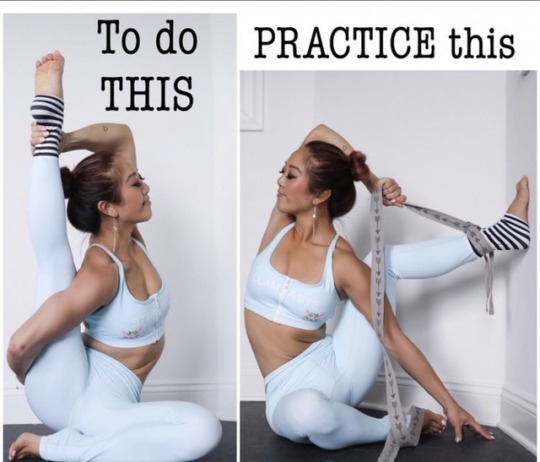
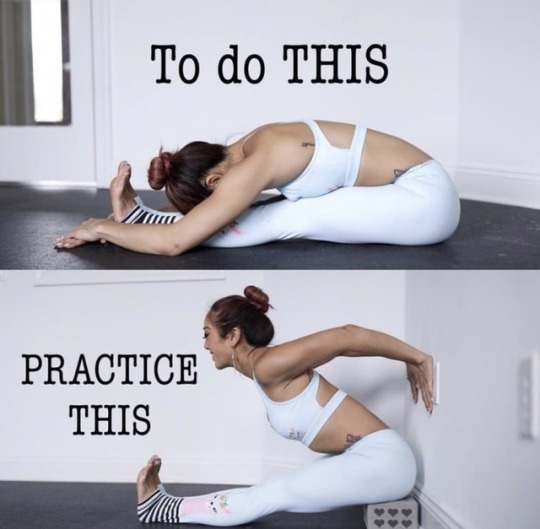



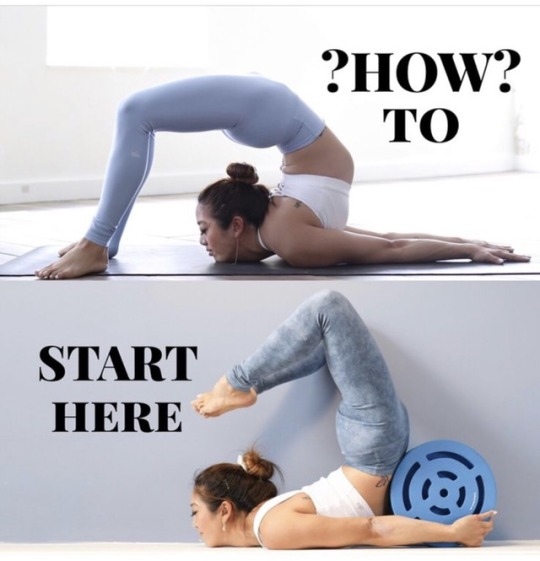


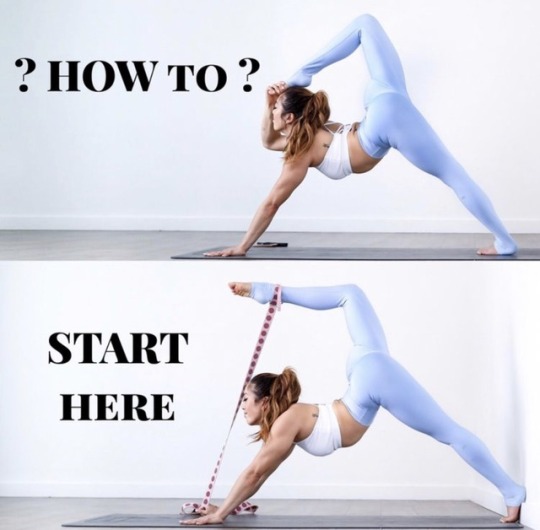

IG: jl.yoga More helpful tips of yoga, and remember yoga takes time 🌱
6K notes
·
View notes
Text
10 Yoga Truths Beginners Might Not Believe (Yet)

By Yoga Sol student, Emily Henry:
I started doing yoga a few months ago and have been amazed at all the yoga myths I’ve dispelled in my short but enlightening journey. Yoga is immediately rewarding and invigorating and I fell in love with it at once. From the beginning, I’ve always left class feeling energized and inspired, no matter what demons I faced during the course of practice. But yoga can also be intimidating, especially if you’re telling yourself untruths. One major myth beginners often buy into, myself included, is that you can’t do a pose and will never be able to do it because your body just isn’t made that way. I felt like this about Reclining Hero Pose, Supta Virasana. I didn’t see how it was possible to get my backside anywhere near the floor, let alone start leaning back. My thighs were in the way, I told myself, and that’s just the way I’m built. But guess what? I kept going to class and sitting in that knee-knocked, splayed leg position, and one day recently I touched the floor. I looked down at my legs and thought how strange and wonderful I looked. That’s the amazing thing about yoga: every class holds some seemingly small triumph that has the power to change everything.
So, to all the other beginners out there, here’s a few other “untruths” I’ve learned that I’d like to share:
1. Not everyone at yoga is skinny and really flexible. In fact, the people in yoga classes are usually very diverse, ranging from high school athletes to seniors, and everything in between. There are some people who can headstand in a couple of breaths, and others who can’t even touch their toes. I’m in the latter category.
2. You’re going to sweat more in a hot yoga class than you would doing your regular cardio routine, or maybe even if you were running for your life away from a bear. You’re going to sweat in places you didn’t think you could even sweat, like your shins and elbows. You’re going to look like you went swimming with your clothes on. But it’s worth it.
3. You’re not sweating because you’re unfit. You’re sweating because you’re working hard and your body is trying to cool you down. Look around in class. Everyone is sweating. And if they’re not sweating, they’re not doing it properly.
4. You’re going to feel high, and low. You might feel invincible and like the king of the world in one pose, and yet insignificant and pathetic in another. You might feel sad or happy, or switch back and forth. Certain poses might even bring up old memories or sore emotional points. It’s not just crazy-hippy-yoga talk. It really is an emotional roller coaster.
5. You might feel like puking or passing out, but you won’t. Tara, the owner Yoga Sol, says she’s taught thousands of students in her yoga career and never once has anyone puked or fainted in class. More than half of the battle is mental, and some days will be better than others. Every class I know it’s coming when we start moving into Camel Pose, Ustrasana, and I remember to tell myself that it’s just a feeling and my mind is stronger than my body. Some days are better than others, but if you’re really feeling it, here’s a tip from Tara: sucking on a mint helps. I’ve tried it, and it’s true.
6. You really do need to breathe the way they tell you to. No, really. At first I thought that maybe it was just for show or to ensure you didn’t hold your breath, but I now know that practicing Ujjayi Breathing actually makes you more powerful and flexible in your poses. I don’t fully have the hang of it yet, but that’s why we call it “practice.”
7. Your mat probably sucks. If you just started yoga and you picked up some $20 mat from Target, you’re going to start experiencing problems pretty soon, like not being able to keep your feet in the proper position for your Warrior Poses because the mat is too slippy. It’s all about quality, grip and padding when it comes to a good yoga mat, and they can cost up to hundreds of dollars for the real pro stuff. But you can get a very good mat starting at about $60. Ask your yoga instructors for recommendations.
8. The less clothing, the better, especially when it comes to taking a hot yoga class. Also, the more form fitting clothing, the better. Don’t wear sweats or t-shirts. Feel free to strip down to your sports bra, for women, or a bare chest, for men. Couple with proper yoga bottoms or shorts.
9. Yoga isn’t just meditation and stretching. It’s an intense, hard workout. Yes, you can lose weight if you stick with it and eat healthily. Yes, you can gain muscle and tone your body. Yes, you can even do yoga for cardio: see if your yoga studio offers classes such as yoga TRiX or yoga boxing. Even flow class can be a cardio workout, as you constantly move from one posture to another.
10. Your favorite pose will be last Savasana, and not simply because you get to relax, but because if you’ve really earned it — you’ll feel euphoric. You may have amazing ideas (this blog post was thought up while in Savasana), memories or spiritual insights. You may even start to hallucinate a little, in a good way. The harder you work, the bigger the pay off.
Questions? Thoughts to share? Leave a comment below.
354 notes
·
View notes

